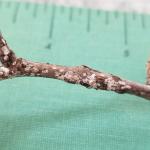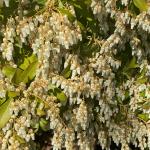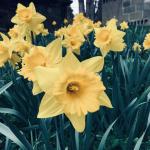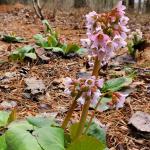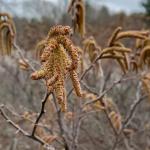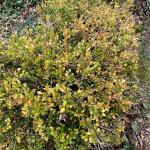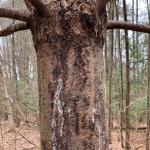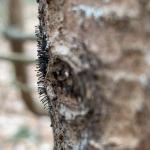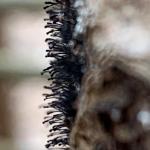UMass Extension's Landscape Message is an educational newsletter intended to inform and guide Massachusetts Green Industry professionals in the management of our collective landscape. Detailed reports from scouts and Extension specialists on growing conditions, pest activity, and cultural practices for the management of woody ornamentals, trees, and turf are regular features. The following issue has been updated to provide timely management information and the latest regional news and environmental data.
Happy Arbor Day! While operations at the University of Massachusetts Amherst have been significantly reduced in response to the COVID-19 pandemic, UMass Extension has developed a listing of resources for commercial horticulture operations in Massachusetts to help keep you informed and aware of relevant policies and best practices for landscapers, turf managers, arborists, nurseries, garden centers, and greenhouse producers.
For our COVID-19 Information and Support for Landscapers, Nurseries, Turf Managers, Garden Centers, Arborists, and Greenhouse Operations in Massachusetts, go to https://ag.umass.edu/landscape/news/covid-19-information-support-for-landscapers-nurseries-turf-managers-garden-centers.
The Landscape Message will be updated weekly in May. The next message will be posted on May 1. To receive immediate notification when the next Landscape Message update is posted, be sure to join our e-mail list.
To read individual sections of the message, click on the section headings below to expand the content:
Scouting Information by Region
Environmental Data
The following data was collected on or about April 22, 2020. Total accumulated growing degree days (GDD) represent the heating units above a 50° F baseline temperature collected via our instruments for the 2020 calendar year. This information is intended for use as a guide for monitoring the developmental stages of pests in your location and planning management strategies accordingly.
|
MA Region/Location |
GDD |
Soil Temp |
Precipitation |
Time/Date of Readings |
||
|
2-Week Gain |
2020 Total |
Sun |
Shade |
|||
|
CAPE |
4.5 |
14.5 |
42 |
41 |
1.54 |
12:00 PM 4/22 |
|
SOUTHEAST |
6 |
22.5 |
43 |
52 |
2.55 |
3:00 PM 4/22 |
|
NORTH SHORE |
7.5 |
40.0 |
45 |
37 |
2.26 |
3:00 PM 4/22 |
|
EAST |
8 |
53.5 |
49 |
45 |
3.23 |
5:00 PM 4/22 |
|
METRO |
4 |
34 |
39 |
37 |
4.16 |
5:30 AM 4/22 |
|
CENTRAL |
3 |
33.0 |
35 |
32 |
2.29 |
7:30 AM, 4/22 |
|
PIONEER VALLEY |
3.5 |
19.0 |
48 |
40 |
2.92 |
3:00 PM 4/22 |
|
BERKSHIRES |
5 |
14.5 |
39 |
37 |
2.86 |
8:15 AM 4/22 |
|
AVERAGE |
5 |
29 |
43 |
40 |
2.73 |
- |
|
n/a = information not available |
||||||
Phenology
| Indicator Plants - Stages of Flowering (BEGIN, BEGIN/FULL, FULL, FULL/END, END) | ||||||||
|---|---|---|---|---|---|---|---|---|
|
PLANT |
CAPE |
SE |
NS |
EAST |
METRO |
CENT |
PV |
BERK |
|
Amelanchier spp. (shadbush, serviceberry) |
Begin |
* |
* |
Begin |
* |
* |
Begin |
* |
|
Pyrus calleryana (Callery pear) |
Begin/Full |
Full |
* |
Begin/Full |
Begin/Full |
Begin/Full |
Full |
* |
|
Magnolia soulangiana (saucer Magnolia) |
Full |
Full |
Full |
Full |
Begin/Full |
Begin/Full |
Full |
Begin |
|
Prunus serrulata (Japanese flowering cherry) |
* |
* |
Full |
Full |
Full |
Full |
Full |
Begin |
|
Rhododendron 'P. J. M.' |
Begin/Full |
Full |
Full |
Full |
Full |
Begin/Full |
Begin/Full |
Begin |
|
Forsythia x intermedia (border Forsythia) |
Full/End |
Full/End |
Full/End |
Full/End |
Full/End |
Full/End |
Full/End |
Full |
|
Rhododendron mucronulatum (Korean Rhododendron) |
* |
* |
* |
Full/End |
Full/End |
Full/End |
End |
Begin/Full |
|
Magnolia stellata (star Magnolia) |
Full |
Full/End |
Full/End |
End |
Full/End |
Full/End |
Full/End |
Full |
|
Pieris japonica (Japanese Pieris) |
Full/End |
Full/End |
Full |
Full |
Full/End |
Full/End |
Full/End |
Full |
|
Cornus mas (Cornelian cherry dogwood) |
* |
End |
End |
End |
Full/End |
Full/End |
End |
Full/End |
| * = no activity to report/information not available | ||||||||
Regional Notes
Cape Cod Region (Barnstable)
General Conditions: During the period from April 8 – April 22, there was an average temperature of 44˚F, with a high of 57˚F on April 13 and a low of 27˚F on April 21. For the most part, daytime highs have been in the 40s or low 50s with nighttime temperatures in the 30s. The low temperatures of April 21 caused some freeze damage to Hosta and some Hydrangea buds. The period also included numerous light frosts as well as a little snow on the morning of April 18. The past two weeks have also been fairly windy. During the period, 1.54 inches of precipitation fell over numerous precipitation events. Overall, subsoil and topsoil moisture remain adequate.
Pests/Problems: Lecanium scale populations are still really high across much of the Cape. The fine mist (honeydew) that will lead to sooty mold has started. From now until the time when the females have matured (June), there will likely be a lot of honeydew in areas with high populations. Before treating, take a close look to determine whether natural control from predators, parasitoids, or entomopathogenic fungi is occurring. Dormant oil applications should be targeted at 35-155 GDD base 50. (See pictures for images of healthy Lecanium scale and scale that has been naturally controlled.)
In general, treatment for winter moth and gypsy moth control on woody ornamentals on Cape Cod are no longer warranted. However, PHC technicians should keep an eye out for other pests, including fall cankerworm, which caused isolated areas of defoliation on the upper Cape last year. Fall cankerworm caterpillars are difficult to distinguish from winter moth caterpillars.
The decline and death of oak trees in unmanaged landscapes on Cape Cod as a result of numerous past stresses is likely to continue. Trees that were stressed by past events or continue to be stressed by current events are at increased susceptibility to attack by pathogens such as Armillaria and boring insects such two lined chestnut borer and red oak borer that may lead to tree death. Symptoms such as crown dieback are often the first visible sign that a tree is in decline.
Weeds in bloom include bittercress (Cardamine hirsuta), mouse-ear cress (Arabidopsis thaliana), fig buttercup/ lesser celandine/ Ranunculus ficaria (Ficaria verna), whitlow grass (Draba verna), and speedwell (Veronica spp). Dandelions (Taraxacum officinale) and common violet (Viola papilionacea) are just beginning to flower. It’s a good time to pull small invasive shrubs like honeysuckle, burning bush, multiflora rose, etc. Looks like another banner year for rabbits. Keep yourself protected from ticks!
Southeast Region (Dighton)
General Conditions: There was frequent precipitation throughout the period from April 8 – April 22, with daytime temperatures in the forties and fifties and nighttime temperatures in the low thirties. We had a light frost and ice in the birdbath some mornings. A storm with very high winds caused significant damage to trees and caused power outages the first week. The following week we had snow. Most lawns, if not evenly green, are at least ready for a second cut. Buds on rose, Hydrangea and other woody plants are swelling. The following plants are in bloom: Cornus mas, Narcissus, daffodils, early tulips, Trillium grandiflorum, Lunaria annua, Phlox subulata, Vinca minor, pansy, Forsythia x intermedia, Muscari, Scilla siberica, Hyacinthus orientalis, Leucojum vernum, Pulmonaria, Chaenomeles, Pieris japonica, Prunus subhirtella, P. cerasifera, P. persica, Pyrus, Acer rubrum, A. platanoides, Magnolia stellata, M. soulangeana, and PJM Rhododendrons.
Pests/Problems: It's a good time to inspect for winter kill and deadwood. Dandelions are making themselves apparent. Ground ivy, chickweed and annual meadow grass (Poa annua) are also flowering. Seeds of chickweed, smartweed and many other weeds are germinating. (See weed report below in this Landscape Message.) Ticks are active. Black flies are biting.
North Shore (Beverly)
General Conditions: The month of April continues to be unseasonably cool for this time of the year. The average temperature in the last two weeks was around 44 degrees Fahrenheit. The day temperatures were mostly in the mid-40s to low 50s except for April 13 and 19 when day temperatures climbed up to 62˚F. Night temperatures were mostly in the low to high 30s during this period. Approximately 2.26 inches of rainfall was recorded at Long Hill during this two week period. There is adequate soil moisture to allow for optimal growth of plants. However, the growth of most plants has slowed down due to cool temperatures. Lawns are greening up and other landscape plants are coming into bloom. Spring flowering herbaceous plants in full bloom include: Daffodils (Narcissus spp.), bloodroot (Sanguinaria canadensis), and glory of the snow (Chionodoxa luciliae). Woody plants seen in bloom include: Merrill Magnolia (Magnolia x loebneri ‘Merrill’), Japanese Pieris (Pieris japonica),weeping higan cherry(Prunus subhirtella)and Katsura tree (Cercidiphyllum japonicum). The plants in bloom have had an extended bloom time because of the consistently cool weather.
Pests/Problems: No major pest activity was observed but ticks are active. It is important to protect yourself when working outdoors with a repellent such as DEET.
East Region (Boston)
General Conditions: The past two weeks have been unseasonably cool for mid-April. We have had seven consecutive days below the seasonal average. Daytime temperatures averaged 52.5°F with a high of 62.6°F on the 19th; we only reached a high of 37°F on the April 22. Low temperatures averaged 35.6°F, ranging from 30.0°F to 50.9°F with several light frosts. We received 1.6” of snow on April 18 which quickly melted the following day under bright sunny skies. Soil moisture remains adequate having accumulated 3.23 inches of precipitation over the reporting period. We accumulated 8.0 GDDs over this period, on April 13-14. Visually spring has arrived as there is plenty of color in the landscape. Cherries, daffodils, Magnolias, pears and Rhododendrons are out in abundance.
Pests/Problems: Chronic invasive vegetation is thriving throughout the landscape. Ficaria verna (lesser celandine) is flourishing and flowering. The red shoots of Fallopia japonica (Japanese knotweed) continue to emerge. Alliaria petiolata (garlic mustard) rosettes and seedlings are prevalent. Ornithogalum umbellatum (star of Bethlehem) foliage is invading turf and mulched beds. The unmistakable chartreuse Acer platanoides (Norway maple) flowers are visible throughout the canopy as their seedlings are germinating beneath. There is still time to prune Viburnum leaf beetle (Pyrrhalta viburni) egg sites out of susceptible Viburnum.
Metro West (Acton)
General Conditions: Happy belated Earth Day and Happy Arbor Day! The landscape is filled with color as a result of the recent warm weather, longer days and precipitation. The wet, snowy and rainy spring-like weather continued into this two-week reporting period. Lawns are greening up and growing and leaves and flower buds are expanding on trees and shrubs. As the proverb says, April showers, bring May flowers. I’m looking forward to it! Observed in some stage of bloom this past week were the following woody plants: Chaenomeles speciosa (common flowering quince), Cornus mas (Cornelian cherry dogwood), C. officinalis (Japanese Cornelian cherry), Forsythia spp., Lindera benzoin (common spicebush), Magnolia x loebneri 'Merrill', (Merrill Magnolia), M. x soulangeana (saucer Magnolia), Pieris japonica (Japanese Pieris), Prunus spp. (cherry), Pyrus spp. (pear), Rhododendron mucronulatum (Korean Rhododendron),and R. 'P. J. M.' (PJM Rhododendron). Contributing even more color and interest to the landscape are some flowering herbaceous plants and spring ephemerals including: Anemone nemorosa (wood Anemone), Asarum europaeum (European ginger), Caltha palustris (marsh marigold), Scilla luciliae (formerly Chionodoxa luciliae or glory of the snow), Crocus spp. (crocus), Dicentra cucullaria (Dutchman's breeches), D. spectabilis (old fashioned bleeding heart), Epimedium versicolor 'Sulphureum' (yellow flowering barrenwort), Helleborus niger (Christmas rose), Hyacinthus spp. (Hyacinth), Mertensia virginica (Virginia bluebells), Muscari sp. (grape Hyacinth), Narcissus spp. (daffodil), Omphalodes verna (blue-eyed Mary), Pachysandra procumbens (Allegheny spurge), Petasites japonicus (Japanese butterbur), Primula spp. (primrose), Pulmonaria longifolia (lungwort), P. rubra (salmon colored lungwort), Puschkinia libanotica (striped squill), Sanguinaria canadensis (bloodroot), S. canadensis 'Multiplex' (double bloodroot), Scilla siberica (Siberian squill), Trillium erectum (red flowering Trillium), Tulipa spp. (tulip), Vinca minor (periwinkle) and Viola spp. (violet).
Pests/Problems: Soils are well saturated and could be an issue for planting and digging in some areas. Acer platanoides (Norway maple) is in bloom. This invasive tree is hard to miss now that it is in bloom and its flowers are a bright yellowish-green and are easily seen on trees found growing most everywhere. The combination of strong winds and rain have blown the cherry blossoms from their trees and the cold morning temperatures have browned some Magnolia flowers.
Central Region (Boylston)
General Conditions: During the reporting period we experienced the wild temperature swings we should expect at this time of year. Several gorgeous, sunny and warm spring days were sandwiched between cold, wet weather. Low temperatures were consistently below freezing and dipped into the upper 20’s twice during the reporting period. The prolonged cold temperatures have caused many of our early spring flowering plants to hold blossoms longer, particularly spring bulbs. Both Scilla siberica (Siberian squill) and S. luciliae (glory of the snow) have been blooming for several weeks and are still quite spectacular. Narcissus (daffodils) have been incredible this spring, and appear to be at their peak. We’re now into that time of year where it’s difficult to keep up with what’s in bloom. Here is a sample of what is currently blooming in the garden: Bergenia crassifolia (heart-leaf bergenia), Houstonia caerulea (bluets), Dicentra cucullaria (Dutchman’s breeches), Lindera benzoin (spicebush), Pieris floribunda (mountain pieris), Anemone acutiloba (sharp-leaved hepatica), Prunus cerasus ‘Pendula Rosea’ (weeping higan cherry), hellebore hybrids, Brunnera macrophylla (Siberian blugloss), Xanthorhiza simplicissima (yellowroot), and Jeffersonia diphylla (twinleaf).
Pests/Problems: A late season snowstorm on April 18 brought heavy wet snow that damaged many tree branches, particularly white pines. Soils are generally waterlogged, making many gardening tasks difficult. Many invasive species are quite apparent at this time of year because they leaf out earlier than most native species. It’s a good time to identify and remove barberry (Berberis thunbergii), Russian and autumn olive (Eleagnus spp.), privet (Ligustrum spp.), and Oriental bittersweet (Celastrus orbiculatus) among others. Ticks continue to be quite active. Deer browse continues to be heavy this spring.
Pioneer Valley Region (Easthampton)
General Conditions: Variable spring weather was on full display in the Pioneer Valley over this past reporting period. High temperatures have ranged anywhere from the lower 40s to mid 60s, while nights continually dip close to or below freezing. We endured a stretch with persistent winds >20 mph and gusts >35 mph from 4/9–4/11, 4/13, and 4/21–4/22, reported at Westover AFB. The region experienced three rainstorms on 4/9, 4/13 and 4/21, along with wet and heavy snowfall during the early hours of 4/18. Thankfully, the snow was gone by the following day and total precipitation from the rain and snow totaled almost 3ʺ. The rainfall on 4/13 was actually welcome, after the persistently windy weather had started to dry the surface of soils in full sun settings. Soil moisture is definitely plentiful and this is a good time to plant new trees and shrubs to maximize new root growth and reduce the effects of transplant shock. Mostly sunny skies were also abundant during this mid-April stretch, providing good overall conditions for working in the landscape. Plant development continues to progress, despite the unsettled weather. Leaves are slowly expanding on rosaceous hosts like crabapple and hawthorn, buds have broken on elm, dogwood, Viburnum and Forsythia, while buds continue to swell on beech, birch and oak. Pine candles are elongating, arborvitae hedges are greening and buds on yews are swollen and ready to break. Rhododendron and azalea buds are also swelling and this looks to be a great year for blooms on these landscape favorites. Turf grasses continue to green and the mowing season has commenced in several yards. Many herbaceous perennials are flowering at this time, including hellebore, grape hyacinth, lungwort, primrose and bloodroot.
Pests/Problems: Grubs are maturing and slowly making their way to the surface of the soil. If they represent one of the invasive trio (Japanese, Oriental and Asiatic Garden beetles), high populations can sometimes damage woody plants by feeding on fine roots. Deer browsing activity seems to be waning but rabbits are busy snipping flowers and tender shoots and mole tunneling is quite active. Now is a good time to scout for the elongate hemlock scale and make plans for treatment. This small, armored scale adheres to the underside of hemlock and fir needles, using its piercing and sucking mouthparts to extract fluids. Winter burn on boxwood and dwarf Alberta spruce is visible at this time but in general, winter-related injuries are not a major concern this spring. Winter injury on boxwood may occur in conjunction with infestations of the boxwood leafminer, which appears to be quite serious on some hedges this spring (see photos). Many fungal pathogens that attack newly developing foliage and shoots on trees and shrubs are not yet active with nighttime temperatures remaining cold. Insect activity remains low as well, although mosquitoes have been active during the brief warm stretches.
Berkshire Region (Great Barrington)
General Conditions: For most of the past two weeks, it has felt more like early March than mid-April. Over the last 14 days, daytime highs were below normal for 10 days, and low temperatures were below the norm on 9 of those days. A low of 25˚F was recorded in West Stockbridge on the morning of April 22. Snow fell on 5 days since April 8, but snowfalls either changed to rain or the sun emerged and melted any accumulated snow. The heaviest snowfall was on April 16 as 3 inches of fluffy snow fell. According to the National Weather Service, these conditions (i.e. chilly, wet weather) will persist for another three weeks. Soil moisture is high, often saturated, and soil surfaces are often frozen in the early morning hours. The combination of cold and wet soils makes any planting and/or seed sowing difficult. Turfgrass growth has been slow but is high enough that mowing may be necessary.
Pests/Problems: There is very little pest activity. Yet, deer tick populations remain high and it is very easy to pick up a tick or several while doing clean-up work, especially removing leafy debris. Boxwood leaf miner larvae can be found by examining boxwood with blistered leaves. Some winter injury has been found on both needled and broadleaf evergreens but the amount of damage is less than usual.
Regional Scouting Credits
- CAPE COD REGION - Russell Norton, Horticulture and Agriculture Educator with Cape Cod Cooperative Extension, reporting from Barnstable.
- SOUTHEAST REGION - Brian McMahon, Arborist, reporting from the Dighton area.
- NORTH SHORE REGION - Geoffrey Njue, Green Industry Specialist, UMass Extension, reporting from the Long Hill Reservation, Beverly.
- EAST REGION - Kit Ganshaw & Sue Pfeiffer, Horticulturists reporting from the Boston area.
- METRO WEST REGION – Julie Coop, Forester, Massachusetts Department of Conservation & Recreation, reporting from Acton.
- CENTRAL REGION - Mark Richardson, Director of Horticulture reporting from Tower Hill Botanic Garden, Boylston.
- PIONEER VALLEY REGION - Nick Brazee, Plant Pathologist, UMass Extension Plant Diagnostic Lab, temporarily reporting from Easthampton.
- BERKSHIRE REGION - Ron Kujawski, Horticultural Consultant, reporting from Great Barrington.
Woody Ornamentals
Diseases
The UMass Plant Diagnostic Lab remains closed at this time to sample submission. Once the lab is allowed to reopen and resume activities, we will share this information immediately.
Needle cast fungi will be active soon as temperatures continue to (slowly) increase. Most of these pathogens initiate new infections on developing needles in the spring but symptoms of infection may not become apparent for many months. Examples include Rhizosphaera and Stigmina needle cast of blue/white spruce, Rhabdocline needle cast of Douglas-fir, and Cyclaneusma needle cast of hard pines. If applying fungicides, begin when new growth emerges and on regular intervals throughout the spring. Fungicides are most appropriate on young and recently transplanted trees and may have a very limited effect on large and mature trees with well-established infections. Management that improves air flow and removes dead and dying branches in the lower canopy should also be performed.
The “eyelash-like” fruiting structures of Caliciopsis pinea, cause of Caliciopsis canker of white pine, are visible at this time. They are very small, but if you closely inspect the main trunk of symptomatic white pines you can often find them. Symptoms include old and fresh resin streaks on the trunk and rough, cankered bark (see photos). The use of a hand lens or magnifying glass can aid in identifying these structures.
The cool weather has slowed the development of certain rust fungi, like Gymnosporangium clavipes. The cedar-quince pathogen will soon be producing eruptive pads of fungal tissue from perennial stem cankers on Juniperus. The pads are reddish in color first, becoming orange and gelatinous when wetted. There are several other rust diseases caused by species of Gymnosporangium that occur in the landscape: cedar-apple rust (G. juniperi-virginianae); cedar-hawthorn rust (G. globosum); pear trellis rust (G. sabinae). All of these fungal species spend part of their life cycle on a Juniperus host and the remaining portion of their life cycle on a rosaceous host (either apple, crabapple, hawthorn, serviceberry, quince, flowering quince, or mountain-ash). Chemical management is generally not recommended since repeated research trials have shown it results in limited control.
Report by Nick Brazee, Plant Pathologist, UMass Extension Plant Diagnostic Lab, UMass Amherst.
Insects
Insect (and Insect Relatives) Activity & Questions since the Last Landscape Message:
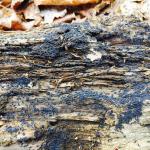 Collembola: The Collembolans, also known as springtails, are closely related to the insects. Many are referred to as springtails because of a structure they possess that allows them to spring or launch themselves away from a potential predator. This structure is called a ‘furcula’. Some species are also referred to as “snow fleas”, but they are not fleas and they do not bite people or pets. They are very small and can be found in large groups, which makes them noticeable. They feed mainly on decaying organic matter, such as dead leaves, wood, algae, fungi, and lichens. They require moist environments to survive, so they are often found associated with damp conditions. The springtime thaw is a time when people notice the Collembola. Many people have been reporting them to UMass Extension over the past few weeks, wondering what they are and why they can be seen crawling on the bark of trees. They also report them disappearing.
Collembola: The Collembolans, also known as springtails, are closely related to the insects. Many are referred to as springtails because of a structure they possess that allows them to spring or launch themselves away from a potential predator. This structure is called a ‘furcula’. Some species are also referred to as “snow fleas”, but they are not fleas and they do not bite people or pets. They are very small and can be found in large groups, which makes them noticeable. They feed mainly on decaying organic matter, such as dead leaves, wood, algae, fungi, and lichens. They require moist environments to survive, so they are often found associated with damp conditions. The springtime thaw is a time when people notice the Collembola. Many people have been reporting them to UMass Extension over the past few weeks, wondering what they are and why they can be seen crawling on the bark of trees. They also report them disappearing.
Springtails are harmless. They do not bite people or pets, they do not damage food, clothes, furniture, or property, they do not sting, and they very rarely damage plants. So, if you have seen these insect relatives, do not worry about them and they do not require management.

 Fireflies: Also referred to as lightning bugs, these insects are not true flies, nor are they in the insect Order referred to as bugs. They are beetles (Coleoptera) in the Family Lampyridae. These are the beetles that many people cherish as wonders of the summertime due to their signaling/communicating behavior. Some species use light-emitting organs on their abdomens to communicate with potential mates. Lightning bugs have been reported to UMass Extension over the past few weeks, seen hiding on the bark of trees (particularly on rough barked trees with cracks and crevices to hide in). These insects are not pests and are not harming the trees they have been spotted on. They should not be managed, but rather, protected.
Fireflies: Also referred to as lightning bugs, these insects are not true flies, nor are they in the insect Order referred to as bugs. They are beetles (Coleoptera) in the Family Lampyridae. These are the beetles that many people cherish as wonders of the summertime due to their signaling/communicating behavior. Some species use light-emitting organs on their abdomens to communicate with potential mates. Lightning bugs have been reported to UMass Extension over the past few weeks, seen hiding on the bark of trees (particularly on rough barked trees with cracks and crevices to hide in). These insects are not pests and are not harming the trees they have been spotted on. They should not be managed, but rather, protected.
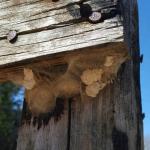
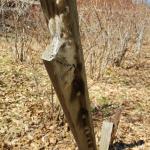 White-Marked Tussock Moth: (Orgyia leucostigma) is a native insect distributed throughout eastern North America. Egg masses are white-cream colored and covered with a foamy material. Eggs may be laid on the cocoon from which the female moth emerged or wrapped within a host plant leaf, nestled in this hard foam. There can be up to 300 eggs per mass. The egg stage is the overwintering stage. Eggs hatch during host plant bloom and larvae feed in hidden locations until they are fully grown, usually in June/July. However, in warmer parts of this insect’s range, there may be two generations per year which means mature caterpillars can be found from May to November. Females are flightless and remain very close to the area where they pupate, mating when winged males arrive, and laying eggs in this location. They are found in fields, woodlands, forests, and host plants include but are not limited to: apple, birch, blueberry, black locust, cherry, elm, hackberry, hickory, oak, rose, willow, and conifers including fir, hemlock, larch, and spruce. Populations are usually not noticeable, although this is considered to be a ubiquitous caterpillar. Pest-level populations have been reported in Christmas tree plantations in the Northeast. Reports of white-marked tussock moth caterpillars causing problems in blueberry fields have occurred in Michigan, and UMass Extension has recently received a report of noticeable numbers of overwintering white-marked tussock moths in a location in western MA. Last year, heavy, localized populations of this insect were reported in Ohio: https://bygl.osu.edu/node/1324 .
White-Marked Tussock Moth: (Orgyia leucostigma) is a native insect distributed throughout eastern North America. Egg masses are white-cream colored and covered with a foamy material. Eggs may be laid on the cocoon from which the female moth emerged or wrapped within a host plant leaf, nestled in this hard foam. There can be up to 300 eggs per mass. The egg stage is the overwintering stage. Eggs hatch during host plant bloom and larvae feed in hidden locations until they are fully grown, usually in June/July. However, in warmer parts of this insect’s range, there may be two generations per year which means mature caterpillars can be found from May to November. Females are flightless and remain very close to the area where they pupate, mating when winged males arrive, and laying eggs in this location. They are found in fields, woodlands, forests, and host plants include but are not limited to: apple, birch, blueberry, black locust, cherry, elm, hackberry, hickory, oak, rose, willow, and conifers including fir, hemlock, larch, and spruce. Populations are usually not noticeable, although this is considered to be a ubiquitous caterpillar. Pest-level populations have been reported in Christmas tree plantations in the Northeast. Reports of white-marked tussock moth caterpillars causing problems in blueberry fields have occurred in Michigan, and UMass Extension has recently received a report of noticeable numbers of overwintering white-marked tussock moths in a location in western MA. Last year, heavy, localized populations of this insect were reported in Ohio: https://bygl.osu.edu/node/1324 .
It is worthwhile to note that white-marked tussock moth caterpillars, cocoons, and any material containing their hairs may cause allergic reactions, particularly if the hairs come into contact with sensitive areas of the skin on sensitive individuals. To avoid risk of an allergic reaction, do not handle caterpillars or their cocoons without gloves. Do not handle caterpillars or their cocoons if you do not have to.
Woody ornamental insect and non-insect arthropod pests to consider, a selected few:
- Winter Moth: Operophtera brumata data since 2017 has indicated that the winter moth population in eastern Massachusetts has been on the decline while the percent of winter moth pupae parasitized by Cyzenis albicans has increased! This is excellent news, as it is data supporting the evidence that winter moth populations have decreased while the parasitic fly, C. albicans, has become established at many locations in New England. Dr. Joseph Elkinton’s laboratory at UMass Amherst has released this biological control of winter moth since 2005 and conducted the rigorous sampling required to determine where the insect has established and what its impact on the winter moth population has been at multiple sites in eastern MA. More information about the Elkinton Lab’s research and the biological control of winter moth can be found here: https://www.fs.fed.us/foresthealth/technology/pdfs/FHAAST-2018-03_Biology_Control_Winter-Moth.pdf
The take-home point? Do not worry about winter moth this spring! In fact, management of this insect in landscaped settings likely will not be necessary in most locations. In recent years, it is worth-while to note that some areas on the Cape and other locations in eastern MA have reported noticeable cankerworm populations in the spring, which are often confused for winter moth. Read more about cankerworms in the spring scouting list below.
In landscape settings in eastern Massachusetts, it is best to wait until the leaves of susceptible hosts completely unfold and monitor for feeding caterpillars, prior to treatment, especially since populations in Massachusetts continue to be so low in many locations. Be sure that management of this insect is necessary by monitoring for damaging populations before making applications in landscape settings. For more information about the life cycle and management of winter moth, please visit thisfact sheet: Winter Moth Identification and Management ( https://ag.umass.edu/landscape/fact-sheets/winter-moth-identification-management ).
Winter moth is a non-native insect that was identified in Massachusetts for the first time in 2003 following persistent reports of defoliation in eastern areas of the state such as Cape Anne and on the North Shore near Cohasset, Hingham, and Rockland on the South Shore in the late 1990’s. For more detailed information about the history of this insect pest in North America and Massachusetts, please visit this fact sheet: Winter Moth in Massachusetts: History and Biological Control ( https://ag.umass.edu/landscape/fact-sheets/winter-moth-in-massachusetts-history-biological-control ).
- Gypsy Moth: (Lymantria dispar) Thanks to the gypsy moth caterpillar killing fungus, Entomophaga maimaiga, the recent outbreak of gypsy moth in Massachusetts has come to an end! Most locations in Massachusetts will not see damaging or even noticeable populations of this insect in 2020. Gypsy moth has been in Massachusetts since the 1860's. This invasive insect from Europe often goes unnoticed, thanks to population regulation provided by the entomopathogenic fungus, E. maimaiga, as well as a NPV virus specific to gypsy moth caterpillars. (And to a lesser extent by many other organisms, including other insects, small mammals, and birds who feed on gypsy moth.) However, if environmental conditions do not favor the life cycle of the fungus, outbreaks of gypsy moth caterpillars are possible. (Such as most recently from 2015-2018, with a peak in the gypsy moth population in 2017 in Massachusetts.)
Missing gypsy moth already? Check out Episode 1 of InsectXaminer to reminisce about the 2015-2018 outbreak of this insect: https://ag.umass.edu/landscape/education-events/insectxaminer
- Asian Longhorned Beetle: (Anoplophora glabripennis, ALB) Look for signs of an ALB infestation which include perfectly round exit holes (about the size of a dime), shallow oval or round scars in the bark where a female has chewed an egg site, or sawdust-like frass (excrement) on the ground nearby host trees or caught in between branches. Be advised that other, native insects may create perfectly round exit holes or sawdust-like frass, which can be confused with signs of ALB activity.
The regulated area for Asian longhorned beetle is 110 miles2 encompassing Worcester, Shrewsbury, Boylston, West Boylston, and parts of Holden and Auburn. If you believe you have seen damage caused by this insect, such as exit holes or egg sites, on susceptible host trees like maple, please call the Asian Longhorned Beetle Eradication Program office in Worcester, MA at 508-852-8090 or toll free at 1-866-702-9938.
To report an Asian longhorned beetle find online or compare it to common insect look-alikes, visit: http://massnrc.org/pests/albreport.aspx or https://www.aphis.usda.gov/pests-diseases/alb/report .
- White Spotted Pine Sawyer (WSPS): Monochamus scutellatus adults can emerge in late May throughout July, depending on local temperatures. This is a native insect in Massachusetts and is usually not a pest. Larvae develop in weakened or recently dead conifers, particularly eastern white pine (Pinus strobus). However, the white spotted pine sawyer looks very similar to the invasive Asian Longhorned Beetle, Anoplophora glabripennis, ALB. ALB adults do not emerge in Massachusetts until July and August. Beginning in July, look for the key difference between WSPS and ALB adults, which is a white spot in the top center of the wing covers (the scutellum) on the back of the beetle. White spotted pine sawyer will have this white spot, whereas Asian longhorned beetle will not. Both insects can have other white spots on the rest of their wing covers; however, the difference in the color of the scutellum is a key characteristic. See the Asian longhorned beetle entry above for more information about that non-native insect.
- Deer Tick/Blacklegged Tick: Check out the archived FREE TickTalk with TickReport webinars available here:https://ag.umass.edu/landscape/education-events/webinars . The next live webinar will be held on May 13, 2020 with Dr. Stephen Rich of the UMass Laboratory of Medical Zoology. Previous webinars including information about deer ticks and associated diseases, ticks and personal protection, and updates from the Laboratory of Medical Zoology are archived at the link above.
Ixodes scapularis adults have been active all winter, as they typically are from October through May, and “quest” or search for hosts at any point when daytime temperatures are above freezing. Deer tick nymphs (immatures) are also active, and may be encountered at this time, through August. For images of all deer tick life stages, along with an outline of the diseases they carry, visit: http://www.tickencounter.org/tick_identification/deer_tick .
Anyone working in the yard and garden on springtime cleanup and planting should be aware that there is the potential to encounter deer ticks. The deer tick or blacklegged tick can transmit Lyme disease, human babesiosis, human anaplasmosis, and other diseases. Preventative activities, such as daily tick checks, wearing appropriate clothing, and permethrin treatments for clothing (according to label instructions) can aid in reducing the risk that a tick will become attached to your body. If a tick cannot attach and feed, it will not transmit disease. For more information about personal protective measures, visit: http://www.tickencounter.org/prevention/protect_yourself .
Have you just removed an attached tick from yourself or a loved one with a pair of tweezers? If so, consider sending the tick to the UMass Laboratory of Medical Zoology to be tested for disease causing pathogens. To submit a tick to be tested, visit: https://www.tickreport.com/ and click on the blue “Order a TickReport” button. Results are typically available within 3 business days, or less. By the time you make an appointment with your physician following the tick attachment, you may have the results back from TickReport to bring to your physician to aid in a conversation about risk.
The UMass Laboratory of Medical Zoology does not give medical advice, nor are the results of their tests diagnostic of human disease. Transmission of a pathogen from the tick to you is dependent upon how long the tick had been feeding, and each pathogen has its own transmission time. TickReport is an excellent measure of exposure risk for the tick (or ticks) that you send in to be tested. Feel free to print out and share your TickReport with your healthcare provider.
- Emerald Ash Borer: (Agrilus planipennis, EAB) Since the New Year, the Massachusetts Department of Conservation and Recreation has confirmed at least 18 new community detections of emerald ash borer in Massachusetts. While the cities and towns with recent detections of EAB are too numerous to list here, they are in areas of Essex, Franklin, Hampshire, Middlesex, Norfolk, and Worcester counties. It is worthwhile to note that this was the first confirmation of EAB in Franklin County. A map of these locations and others previously known across the state may be found here: https://ag.umass.edu/fact-sheets/emerald-ash-borer .
This wood-boring beetle readily attacks ash (Fraxinus spp.) including white, green, and black ash and has also been found developing in white fringe tree (Chionanthus virginicus) and has been reported in cultivated olive (Olea europaea). Adult insects of this species will not be present at this time of year. Signs of an EAB infested tree may include (at this time) D-shaped exit holes in the bark (from adult emergence in previous years), “blonding” or lighter coloration of the ash bark from woodpecker feeding (chipping away of the bark as they search for larvae beneath), and serpentine galleries visible through splits in the bark, from larval feeding beneath. Positive identification of an EAB-infested tree may not be possible with these signs individually on their own.
For further information about this insect, please visit: https://ag.umass.edu/fact-sheets/emerald-ash-borer . If you believe you have located EAB-infested ash trees, particularly in an area of Massachusetts not identified on the map provided, please report here: http://massnrc.org/pests/pestreports.htm .
- Spotted Lanternfly: (Lycorma delicatula, SLF) is not known to occur in Massachusetts landscapes (no established populations are known in MA at this time). However, due to the great ability of this insect to hitchhike using human-aided movement, it is important that we remain vigilant in Massachusetts and report any suspicious findings. Spotted lanternfly reports can be sent here:https://massnrc.org/pests/slfreport.aspx
For a map of known, established populations of SLF as well as detections outside of these areas where individual finds of spotted lanternfly have occurred (but no infestations are present), visit: https://nysipm.cornell.edu/environment/invasive-species-exotic-pests/spotted-lanternfly/ This map depicts an individual find of spotted lanternfly at a private residence in Boston, MA that was reported by the MA Department of Agricultural Resources on February 21, 2019. More information about this detection in Boston, where no established infestation was found, is provided here: https://www.mass.gov/news/state-agricultural-officials-urge-residents-to-check-plants-for-spotted-lanternfly
This insect is a member of the Order Hemiptera (true bugs, cicadas, hoppers, aphids, and others) and the Family Fulgoridae, also known as planthoppers. The spotted lanternfly is a non-native species first detected in the United States in Berks County, Pennsylvania and confirmed on September 22, 2014.
The spotted lanternfly is considered native to China, India, and Vietnam. It has been introduced as a non-native insect to South Korea and Japan, prior to its detection in the United States. In South Korea, it is considered invasive and a pest of grapes and peaches. The spotted lanternfly has been reported from over 70 species of plants, including the following: tree of heaven (Ailanthus altissima) (preferred host), apple (Malus spp.), plum, cherry, peach, apricot (Prunus spp.), grape (Vitis spp.), pine (Pinus spp.), pignut hickory (Carya glabra), sassafras (Sassafras albidum), serviceberry (Amelanchier spp.), slippery elm (Ulmus rubra), tulip poplar (Liriodendron tulipifera), white ash (Fraxinus americana), willow (Salix spp.), American beech (Fagus grandifolia), American linden (Tilia americana), American sycamore (Platanus occidentalis), big-toothed aspen (Populus grandidentata), black birch (Betula lenta), black cherry (Prunus serotina), black gum (Nyssa sylvatica), black walnut (Juglans nigra), dogwood (Cornus spp.), Japanese snowbell (Styrax japonicus), maple (Acer spp.), oak (Quercus spp.), and paper birch (Betula papyrifera).
The adults and immatures of this species damage host plants by feeding on sap from stems, leaves, and the trunks of trees. In the springtime in Pennsylvania (late April - mid-May) nymphs (immatures) are found on smaller plants and vines and new growth of trees and shrubs. Third and fourth instar nymphs migrate to the tree of heaven and are observed feeding on trunks and branches. Trees may be found with sap weeping from the wounds caused by the insect’s feeding. The sugary secretions (excrement) created by this insect may coat the host plant, later leading to the growth of sooty mold. Insects such as wasps, hornets, bees, and ants may also be attracted to the sugary waste created by the lanternflies, or sap weeping from open wounds in the host plant. Host plants have been described as giving off a fermented odor when this insect is present.
Adults are present by the middle of July in Pennsylvania and begin laying eggs by late September and continue laying eggs through late November and even early December in that state. Adults may be found on the trunks of trees such as the tree of heaven or other host plants growing in close proximity to them. Egg masses of this insect are gray in color and look similar in some ways to gypsy moth egg masses.
Host plants, bricks, stone, lawn furniture, recreational vehicles, and other smooth surfaces can be inspected for egg masses. Egg masses laid on outdoor residential items such as those listed above may pose the greatest threat for spreading this insect via human aided movement.
For more information about the spotted lanternfly, visit this fact sheet: https://ag.umass.edu/landscape/fact-sheets/spotted-lanternfly .
Spring Scouting Suggestions:
- Bagworm: Thyridopteryx ephemeraeformis is a native species of moth whose larvae construct bag-like coverings over themselves with host plant leaves and twigs. This insect overwinters in the egg stage, within the bags of deceased females from last season. Eggs may hatch and young larvae are observed feeding around mid-June, or roughly between 600-900 GDD’s. Now is the time to scout for and remove and destroy overwintering bags. In certain areas across MA in 2019, increased populations of bagworms were observed and reported. More information can be found here: https://ag.umass.edu/landscape/fact-sheets/bagworm
- Balsam Twig Aphid: Mindarus abietinus overwinters as a silvery colored egg on host plant twigs. Eggs hatch just prior to budbreak and nymphs feed for a period of time on the undersides of last season’s needles before molting into a wingless stem mother. Stem mothers move to buds just as they open and give “live birth” to second generation nymphs. These second generation nymphs are the most damaging, feeding on new needles as they elongate, causing distortion and stunting. Excessive amounts of honeydew may be produced and cause needles to stick together. Foliar applications, if needed, may be made between 30-100 GDD’s, base 50°F on warm days before budcaps loosen. Inspect the twigs near the base of needles of Balsam fir, Fraser fir, and other true firs for overwintering eggs and soon after check the needles for feeding nymphs. This insect may be most problematic in Christmas tree production. In landscapes, many natural enemies can provide adequate management of this insect.
- Boxwood Leafminer: Monarthropalpus flavus partly grown fly larvae overwinter in the leaves of susceptible boxwood. Yellowish mines may be noticeable on the undersides of leaves. This insect grows rapidly in the spring, transforming into an orange-colored pupa. After pupation, adults will develop and white colored pupal cases may hang down from the underside of leaves where adults have emerged. Adults may be observed swarming hosts between 300-650 GDD’s, or roughly the end of May through June. Most cultivars of Buxus sempervirens and B. microphylla are thought to be susceptible. If installing new boxwoods this spring, resistant cultivars such as ‘Vardar Valley’ and ‘Winter Gem’ are good choices at sites where this insect has been a problem.
- Boxwood Mite: Eurytetranychus buxi overwinter as tiny eggs on boxwood leaves and hatch mid-spring. These mites are tiny (about the size of a period) and difficult to detect. Feeding may cause plants to appear off-color. If management is deemed necessary, the timing for treatment may be between 245-600 GDD’s or roughly the beginning of May.
- Boxwood Psyllid: Psylla buxi feeding can cause cupping of susceptible boxwood leaves. Leaf symptoms/damage may remain on plants for up to two years. English boxwood may be less severely impacted by this pest. Eggs overwinter, are buried in budscales, and hatch around budbreak of boxwood. Eggs may hatch around 80 GDD’s. Foliar applications may be made between 290-440 GDD’s. However, the damage caused by this insect is mostly aesthetic. Therefore, no management may be necessary.
- Cankerworms: Alsophila pometaria (fall cankerworm) and Paleacrita vernata (spring cankerworm) are often confused for winter moth (Operophtera brumata). Cankerworm populations in eastern MA, particularly on areas of Cape Cod, were confused for winter moth in 2019. Spring cankerworm adults were active in February and March, and fall cankerworm adults are active in late November into early December. During these times, both species lay eggs. These native insects most commonly utilize elm, apple, oak, linden, and beech. Eggs of both species hatch as soon as buds begin to open in the spring. Caterpillars occur in mixed populations and are often noticeable by mid-May in MA. Young larvae will feed on buds and unfolding leaves. There are two color forms (green and dark) for caterpillars of both species. Like winter moth, they will drop to the soil to pupate. This usually occurs in June. Fall cankerworm larvae have three pairs of prolegs (one of which is small so it is sometimes referred to as ½ pair) and spring cankerworm have two pairs. (Winter moth caterpillars also have 2 pairs of prolegs.) If populations are large and damage is noticeable on hosts, reduced risk insecticides such as Bacillus thuringiensis Kurstaki or spinosad may target larvae between 148-290 GDD’s.
- Cooley Spruce Gall Adelgid: Adelges cooleyi is a native insect that has a complex life cycle. It has at least five different morphological forms, and requires 2 years and two hosts to complete its normal life cycle. Galls (pineapple shaped/cone-like and at the tips of twigs) are produced on Colorado blue spruce, Engelmann, Sitka, and Oriental spruce and cause needle injury (yellow spots and distortion) to Douglas-fir. Immature females overwinter on spruce near twig terminals. In the early spring, females mature into stem mothers and lay hundreds of eggs on lateral terminals. Upon egg hatch, nymphs migrate to new spring growth and feed at the base of growing needles. Immatures can be targeted on spruce between 22-81 GDD’s (mid-late April). On Douglas-fir, dormant oil applications should be made immediately before budbreak to avoid phytotoxicity. Follow all label instructions.
- Eastern Spruce Gall Adelgid: Adelges abietis is a pest of Norway spruce primarily, but occasionally damages other spruce species such as Colorado blue, white, and red spruce. This adelgid overwinters as a partially grown female, often referred to as a stem mother. This overwintering individual matures around bud break and lays 100-200 eggs. The eastern spruce gall adelgid may be targeted for management between 22-170 GDD’s, base 50°F (mid-April to early-May). This insect is non-native, and was introduced into the United States from Europe before 1900. Galls are small, sometimes pineapple shaped/variable, but produced on the basal portion of the shoots, such that the twig extends beyond the gall. Twig dieback may occur.
- Eastern Tent Caterpillar: Malacosoma americanum eggs overwinter on host plant twigs. Egg hatch typically occurs when wild cherry leaves begin to unfold and young caterpillars may emerge by late-April through the first two weeks in May (90-190 GDD’s). Susceptible hosts include cherry and crabapple. Other host plants whose leaves are fed upon by this native insect can include apple, ash, birch, willow, maple, oak, poplar, and witch-hazel. Prune off and remove egg masses from ornamental host plants by early spring. Eastern tent caterpillars are native to Massachusetts and have many associated natural enemies (parasites and predators) that help regulate populations. Unless these caterpillars are actively defoliating specimen trees in a landscaped setting, we can coexist with this particular herbivore native to our forests.
- Elongate Hemlock Scale: Fiorinia externa is found on eastern, Carolina, and Japanese hemlock, as well as yew, spruce, and fir. The elongate hemlock scale may overwinter in various life stages, and the overlap of many developmental stages at any given time can be observed throughout much of the season. Dormant oil applications for this pest can occur according to label instructions in April, roughly between 7-120 GDD’s. Treatments for the crawler, or mobile, stage of this insect may be made in late May through mid-June, or between 360-700 GDD’s, base 50°F. Nitrogen fertilizer applications may make elongate hemlock scale infestations worse.
- Euonymus Scale: Unaspis euonymi is an armored scale that can be found on euonymus, holly, bittersweet, and pachysandra. This insect can cause yellow spotting on leaves, dieback, and distorted bark. Dormant oil applications can be made between 35-120 GDD’s or roughly from mid-April to early-May. For crawlers, early June timing is suggested between 533-820 GDD’s. (Eggs begin to hatch in early June.)
- European Pine Sawfly: Neodiprion sertifer overwinters in the egg stage. Eggs are laid by females the previous season by cutting slits in needles using their ovipositors and depositing 6-8 eggs in each of 10-12 needles. Egg hatch occurs from late-April to mid-May and caterpillars become active roughly between 78-220 GDD, base 50°F. The primary host in MA is Mugo pine but it can be found on Scots, red, jack, and Japanese red pine. It is also found on white, Austrian, ponderosa, shortleaf, and pitch pine when planted near the aforementioned species. This dark colored caterpillar feeds in tight groups and small numbers can be pruned or plucked out of host plants and destroyed. Spinosad products can be used whenever the caterpillars are actively feeding, usually by mid-May and when caterpillars are still small. Bacillus thuringiensis kurstaki is not effective against sawflies.
- Forest Tent Caterpillar: Malacosoma disstria egg hatch occurs between 192-363 GDD’s, base 50°F, by mid-late May and caterpillars may be active for at least 5-6 weeks following. Susceptible hosts whose leaves are fed on by this insect include oak, birch, ash, maple, elm, poplar, and basswood. This native insect has many natural enemies, including some very effective pathogens that typically regulate populations. However, outbreaks of this insect can occur on occasion.
- Hemlock Looper: Two species of geometrid moths in the genus Lambdina are native insects capable of defoliating eastern hemlock, balsam fir, and white spruce. Adult moths lay their eggs on the trunk and limbs of hosts in September and October, and eggs will hatch by late May or early June. (L. fiscellaria caterpillars may be active between 448-707 GDD’s.) Monitor susceptible hosts for small, inch-worm like caterpillars. Where populations are low, no management is necessary. Hemlock loopers have several effective natural enemies.
- Hemlock Woolly Adelgid: Adelges tsugae is present on eastern and Carolina hemlock. The overwintering hemlock woolly adelgid generation (sistens) is present through mid-spring and produces the spring generation (progrediens) which will be present from early spring through mid-summer. HWA, unlike many other insects, does most of its feeding over the winter. Eggs may be found in woolly masses at the base of hemlock needles beginning in mid-March. Each woolly mass is created by a female who may then lay 50-300 eggs. Eggs hatch and crawlers may be found from mid-March through mid-July. Infested trees may be treated with foliar sprays in late April to early May, using Japanese quince as a phenological indicator. Systemic applications may be made in the spring and fall, or when soil conditions are favorable for translocation to foliage. Nitrogen fertilizer applications may make hemlock woolly adelgid infestations worse.
- Imported Willow Leaf Beetle: Plagiodera versicolora adult beetles overwinter near susceptible hosts. Adult beetles will chew holes and notches in the leaves of willow once they become available. Females lay yellow eggs in clusters on the undersides of leaves. Larvae are slug-like and bluish-green in color. They will feed in clusters and skeletonize the leaves. Most plants can tolerate the feeding from this insect, and foliage will appear brown. Repeated yearly feeding can be an issue, in which case management of the young larvae may be necessary. Take care with treatment in areas near water.
- Lecanium Scales (Oak): Parthenolecanium quercifex overwinters as a second instar nymph on oak twigs. Females will begin feeding and mature in the spring, from mid-April to early May and eggs may be laid between late May and into June. Eggs hatch in June or early July and crawlers migrate to host plant leaves where they spend the summer and migrate as second instars back to host plant twigs in the fall. Mid-April to early-May (35-145 GDD’s) for dormant oil applications.
- Lily Leaf Beetle: Lilioceris lilii adults overwinter in sheltered places. As soon as susceptible hosts such as Lilium spp. (Turk’s cap, tiger, Easter, Asiatic, and Oriental lilies) and Fritillaria spp.break through the ground, the adult lily leaf beetles are known to feed on the new foliage. (Note: daylilies are not hosts.) Typically, in May, mating will occur and each female will begin to lay 250-450 eggs in neat rows on the underside of the foliage. If there are only a few plants in the garden, hand picking and destroying overwintering adults can help reduce local garden-level populations at this time.
- Magnolia Scale: Neolecanium cornuparvum overwinters as first instar nymphs which are elliptical, and dark slate gray in color and can usually be found on the undersides of 1 and 2 year old twigs. Nymphs may molt by late April or May and again by early June at which time the scales may be purple in color. Eventually nymphs secrete a white powdery layer of wax over their bodies. Dormant oils can be applied between 7-35 GDD’s targeting the overwintering nymphs. Avoid applications to opening buds or blooms.
- Pine Bark Adelgid: Pineus strobi overwinters as an immature which begins feeding during the first days of warm weather in the spring and begins secreting white wax over itself, which can eventually coat the entire trunk of infested trees. Egg laying may begin in April. This insect can be found on the trunk, branches, twigs, and the base of needles on new shoots. Spruce is a secondary host but this adelgid can repeatedly reproduce itself on pine. Wash off bark with a strong jet of water. If necessary, dormant oil applications can be made in mid-late April between 22-58 GDDs. Hosts include eastern white, Scots, and Austrian pines. This insect does little damage to healthy trees and can often be tolerated.
- Snowball Aphid: Neoceruraphis viburnicola eggs overwinter on viburnum twigs and buds. Eggs hatch and this aphid becomes active on certain species of viburnum roughly between 148-298 GDD’s or around redbud bloom. This insect is particularly noticeable on V. opulus, V. prunifolium, and V. acerifolia. Stem mothers, appearing blueish-white, can be found in curled up and distorted foliage. Damage caused by this insect pest is mostly aesthetic.
- Spruce Bud Scale: Physokermes piceae is a pest of Alberta and Norway spruce, among others. Immatures overwinter on the undersides of spruce needles, dormant until late March. By April, females may move to twigs to complete the rest of their development. Dormant oil applications may be made between 22-121 GDDs. Follow all label instructions, as oil may remove the bluish color from certain conifers. Mature scales are reddish brown, globular, 3 mm. in diameter, and found in clusters of 3-8 at the base of new twig growth. They closely resemble buds and are often overlooked. Crawlers are present around June.
- Spruce Spider Mite: Oligonychus ununguis is a cool-season mite that becomes active in the spring from tiny eggs that have overwintered on host plants. Hosts include spruce, arborvitae, juniper, hemlock, pine, Douglas-fir, and occasionally other conifers. This particular species becomes active in the spring and can feed, develop, and reproduce through roughly June. When hot, dry summer conditions begin, this spider mite will enter a summer-time dormant period (aestivation) until cooler temperatures return in the fall. This particular mite may prefer older needles to newer ones for food. When damaging spruce spider mite populations are known from last season, dormant oil applications can be made (when temperatures are appropriate according to label instructions) between 7-121 GDD’s, base 50°F (April). Magnification is required to view spruce spider mite eggs. Tapping host plant branches over white paper may be a useful tool when scouting for spider mite presence. (View with a hand lens.) Spider mite damage may appear on host plant needles as yellow stippling and occasionally fine silk webbing is visible.
- Viburnum Leaf Beetle: Pyrrhalta viburni is a beetle in the family Chrysomelidae that is native to Europe, but was found in Massachusetts in 2004. Viburnum leaf beetle overwinters as eggs laid in capped pits on the newest growth of susceptible viburnum branches. Scout for overwintered eggs and prune out and destroy before they hatch. Egg hatch occurs in late-April to early-May as temperatures warm and foliage becomes available. Monitor for larvae in mid-May (80-120 GDD’s). This beetle feeds exclusively on many different species of viburnum, which includes, but is not limited to, susceptible plants such as V. dentatum, V. nudum, V. opulus, V. propinquum, and V. rafinesquianum. Some viburnum have been observed to have varying levels of resistance to this insect, including but not limited to V. bodnantense, V. carlesii, V. davidii, V. plicatum, V. rhytidophyllum, V. setigerum, and V. sieboldii. More information about viburnum leaf beetle may be found at http://www.hort.cornell.edu/vlb/
- White Pine Weevil: Pissodes strobi adults overwinter in sheltered locations in the leaflitter and become active very early in the spring, when daytime temperatures reach 50°F and before the bloom of forsythia (between 7-58 GDDs). Hosts include eastern white pine, Norway spruce, scotch, pitch, and red pine, blue spruce, and white spruce are also susceptible to white pine weevil damage. Adults will begin feeding on bark 7-10 inches below dormant terminal buds. Females will deposit eggs in terminal growth bark, and developing larvae will feed in leaders until they mature in July when pupation occurs in pupal chambers made of wood chips. Management in nurseries or Christmas tree production may be necessary. Target adults between 7-58 GDD’s.
- Woolly Elm Aphid: Eriosoma americanum females lay a single egg in the cracks and crevices of elm bark, where the egg overwinters. Eggs hatch on elm in the spring as leaves are unfolding. Aphids may be active from 121-246 GDD’s, base 50°F on elm. A young, wingless female hatched from the egg feeds on the underside of leaf tissue. This female aphid matures and gives birth to 200 young, all females, without mating. These aphids feed, and the elm leaf curls around them and protects them. By the end of June, winged migrants mature and find serviceberry hosts. Another set of females is produced. These new females crawl to and begin feeding on the roots of serviceberry. Multiple generations occur on the roots of serviceberry through the summer.
Concerned that you may have found an invasive insect or suspicious damage caused by one? Need to report a pest sighting? If so, please visit the Massachusetts Introduced Pests Outreach Project: http://massnrc.org/pests/pestreports.htm .
A note about Tick Awareness: deer ticks (Ixodes scapularis), the American dog tick (Dermacentor variabilis), and the lone star tick (Amblyomma americanum) are all found throughout Massachusetts. Each can carry their own complement of diseases. Anyone working in tick habitats (wood-line areas, forested areas, and landscaped areas with ground cover) should check themselves regularly for ticks while practicing preventative measures. Have a tick and need it tested? Visit the web page of the UMass Laboratory of Medical Zoology (https://www.tickreport.com/ ) and click on the blue Order a TickReport button for more information.
Reported by Tawny Simisky, Extension Entomologist, UMass Extension Landscape, Nursery, & Urban Forestry Program
Weeds
Treat garlic mustard (Alliaria petiolata) now. Applications at this time of year will control second year plants before they go to seed as well as first year seedlings. Look for seedlings at this time as these seedlings will be next year’s flowering plants.
Landscape mulch should be the first defense against weeds in landscape beds. Mulch can be applied now at the beginning of the season before summer annual weeds germinate. Small winter annual weeds can be smothered with mulch. Freshly mulched landscape beds will not immediately require a preemergence herbicide application because the fresh mulch should supply adequate summer annual weed control in the short term. Preemergence herbicide application should be considered on mulched areas that have not been freshly mulched or can be applied later in the season in those areas that were freshly mulched this spring. Preemergence herbicides should be applied on top of landscape mulches not underneath them. Compost is not recommended as a mulching material.
Inspect areas of landscape where new trees or shrubs, especially those that were field grown, have been planted in the last year. Look for perennial weeds that may be growing from the root ball. Canada thistle, mugwort, quackgrass, bindweed and horsenettle are some of the possible culprits.
When scouting for weeds in the landscape, observe areas underneath and around bird feeders. Some of the most interesting weeds that are sent to me come from these areas. Many of these plants are from other regions of the country and therefore have the potential to be aggressive and pernicious.
Treat winter annual and perennial weeds in ornamental beds with glyphosate (Roundup Pro or equivalent) and glufosinate (Finale). These applications are easier if done now before woody ornamentals leaf-out. The new growth of herbaceous perennial ornamentals can be very susceptible to spray drift, so exercise extreme caution. Non-chemical products containing clove oil, citric acid, acetic acid or orange extract can be used on small winter annuals but not on large winter annuals or perennials. Remember these organic/non-chemical products do not translocate and will not control established perennial weeds but will control young winter annual weeds. Many winter annuals are just beginning to flower and have not set seed and should be controlled now. For more information about non-selective herbicides visit (under Trouble Maker of the Month): https://ag.umass.edu/landscape/newsletters/hort-notes/hort-notes-2020-vol-312
Common landscape winter annual weeds being observed now are:
mouse-ear cress Arabidopsis thaliana
thymeleaf sandwort - Arenaria serpyllifolia
downy brome - Bromus tectorum
shepherd's-purse - Capsella bursa-pastoris
bittercress - Cardamine hirsuta
sticky chickweed - Cerastium viscosum
horseweed - Conyza canadensis
spring whitlowgrass - Draba verna
henbit - Lamium amplexicaule
red deadnettle - Lamium purpureum
field pepperweed - Lepidium campestre
Virginia pepperweed - Lepidium virginicum
pineappleweed - Matricaria matricarioides
annual bluegrass - Poa annua
knawel - Scleranthus annuus
common chickweed - Stellaria media
field pennycress - Thlaspi arvense
corn speedwell - Veronica arvensis
purslane speedwell - Veronica peregrina
Japanese knotweed, (Polygonum cuspidatum, a.k.a. Reynoutria japonica, Fallopia japonica), has begun to emerge from rhizomes. Do not attempt to control this weed at this time as herbicide applications are not effective. Repeat cutting or mowing can be used as a non-chemical strategy; if that is the control strategy selected, then cutting and mowing should begin now. Repeat cutting or mowing should be done as regrowth reaches 4 to 6 inches.
Report by Randy Prostak, Weed Specialist, UMass Extension Landscape, Nursery and Urban Forestry Program
Landscape Practices
Spring Pruning of Deciduous Shrubs
Warmer days and “April showers” mean that plants are emerging from dormancy and that spring cleanup is in full swing. This is a great time to think about the do’s and don’ts of spring pruning. “If it blooms before June don’t prune.” Spring blooming species, such as Forsythia and lilac set flower buds on “old wood”, or the previous year’s growth. Pruning these spring blooming species now will result in decreased or no flowering for the year. Summer blooming species such as Clethra and panicle Hydrangea on the other hand bloom on “new wood”, or the current season’s growth. These species can and should be pruned in spring before the summer flowering season. There are some exceptions to this. Dead and damaged branches can be removed at any time. Some older or unkempt species may also be improved by rejuvenation or renewal pruning which can still be done for some species.
The basic categories of pruning are “heading back”, shearing, rejuvenation, and renewal. “Heading back” is a method of controlling plant size. This type of pruning is best done when new growth is complete. Stems and branches should be pruned to just above a new good bud or lateral branch. Shearing should only be done to create a more formal hedge. It is important when shearing to consider sunlight exposure. The upper part of the hedge should be narrower than the bottom allowing for sunlight to reach the lower branches. A wider top of the hedge will result in sparse bottom growth and a leggy appearance. Shearing is best done after new growth is complete. Rejuvenation pruning is pruning all stems to a few inches above ground level. This is best done in late winter to early spring. Plants species that respond well to this treatment are vigorous growers such as Forsythia and Weigela. If removing all stems at once is not desirable, renewal pruning allows for removal of 1/3 of stems per year starting with the oldest or overgrown stems or canes and completing the project in 3-4 years. This is also best done in late winter or early spring.
Shrubs that can be pruned now include Caryopteris x clandonensis (bluebeard), Potentilla species (cinquefoil), Hydrangea paniculata (panicle hydrangea), Hydrangea arborescens (smooth hydrangea), Hibiscus syriacus (rose-of-Sharon), Spiraea japonica and S. x bumalda (summer flowering Spirea), Ilex verticillata (winterberry), Clethra alnifolia (Clethra), Symphoricarpos species (snowberry) and Hamamelis virginiana (common witchhazel).
Shrubs that should wait until after flowering include: Calycanthus floridus (Carolina allspice), Myrica pensylvanica (bayberry), Kolkwitzia amabilis (beautyberry), Aronia species (chokeberry), Cotoneaster species, Deutzia gracilis, Cornus racemosa (gray dogwood), Cornus sericea (redosier dogwood), Forsythia x intermedia, Fothergilla gardenii, Hydrangea quercifolia (oakleaf hydrangea), Kerria japonica (Japanese Kerria), Syringa vulgaris (common lilac), Syringa x persica (Persian lilac), Philadephus species (mockorange), Spirea prunifolia and S. vanhouttei (spring flowering Spirea), Viburnum species, Weigela florida, and Hamamelis vernalis (vernal witchhazel).
Hydrangea macrophylla depends on the cultivar and winter survival. Older cultivars usually bloom on old wood and should be pruned after flowering. Newer cultivars bloom on both new and old wood. It is very common for Hydrangea macrophylla to experience winter damage in Massachusetts which kills buds set the previous year. When growth resumes in spring plants should be evaluated for bud survival. If buds appear dead and new growth is sprouting from the roots, old cans should be removed to ground level. If buds were not damaged head-back after flowering.
Rhododendron species generally need little pruning. Renewal pruning can be done when plants are dormant. Dead or damaged branches can be pruned as needed, especially after spring growth resumes.
Rosa species depends on the type of rose. Climbers and ramblers should be pruned after flowering. Hybrid bush types should be shaped in spring before flowering. Shrub type should have old, diseased, or unwanted canes pruned out in spring then head-backed after flowering.
Report by Mandy Bayer, Extension Assistant Professor of Sustainable Landscape Horticulture, UMass Stockbridge School of Agriculture
Additional Resources
To receive immediate notification when the next Landscape Message update is posted, join our email list by emailing your request to eweeks@umext.umass.edu with Subscribe Greeninfo in the subject line, and follow us on Facebook and Twitter.
For a complete listing of upcoming events, see our upcoming educational events https://ag.umass.edu/landscape/upcoming-events
For commercial growers of greenhouse crops and flowers - Check out UMass Extension's Greenhouse Update website
For professional turf managers - Check out Turf Management Updates
For home gardeners and garden retailers - Check out our home lawn and garden resources. UMass Extension also has a Twitter feed that provides timely, daily gardening tips, sunrise and sunset times to home gardeners at twitter.com/UMassGardenClip
Current Massachusetts and University policy have the effect of temporarily suspending most of the on-campus services that we provide, including but not limited to:
- Soil and Plant Nutrient Testing Lab
- Plant Disease Diagnostics Lab
- Weed, Insect, Turfgrass, and Invasive Plant Identification
Until further notice, please do not send or deliver samples to the campus, as we cannot process them.
Diagnostic Services
A UMass Laboratory Diagnoses Landscape and Turf Problems - The UMass Extension Plant Diagnostic Lab is available to serve commercial landscape contractors, turf managers, arborists, nurseries and other green industry professionals. It provides woody plant and turf disease analysis, woody plant and turf insect identification, turfgrass identification, weed identification, and offers a report of pest management strategies that are research based, economically sound and environmentally appropriate for the situation. Accurate diagnosis for a turf or landscape problem can often eliminate or reduce the need for pesticide use. For sampling procedures, detailed submission instructions and a list of fees, see Plant Diagnostics Laboratory . No samples are being accepted at this time.
Soil and Plant Nutrient Testing - The University of Massachusetts Soil and Plant Nutrient Testing Laboratory is located on the campus of The University of Massachusetts at Amherst. Testing services are available to all. The function of the Soil and Plant Nutrient Testing Laboratory is to provide test results and recommendations that lead to the wise and economical use of soils and soil amendments. For complete information, visit the UMass Soil and Plant Nutrient Testing Laboratory web site. Alternatively, call the lab at (413) 545-2311. No samples are being accepted at this time.
At this time, the TickReport Risk Assessment and Passive Surveillance Program, which is not part of UMass Extension, remains open. Tick samples can continue to be submitted via https://www.tickreport.com . Please contact TickReport with further questions and updates on the status of their service.
Ticks are active any time that temperatures are above freezing! Remember to take appropriate precautions when working and playing outdoors, and conduct daily tick checks. UMass tests ticks for the presence of Lyme disease and other disease pathogens. Learn more

